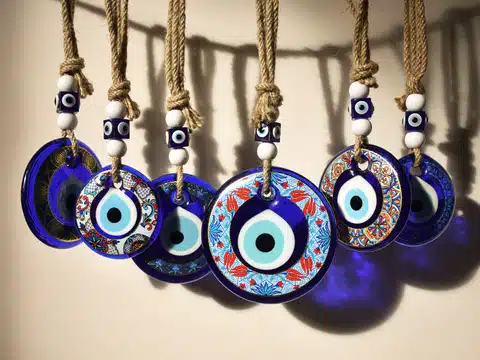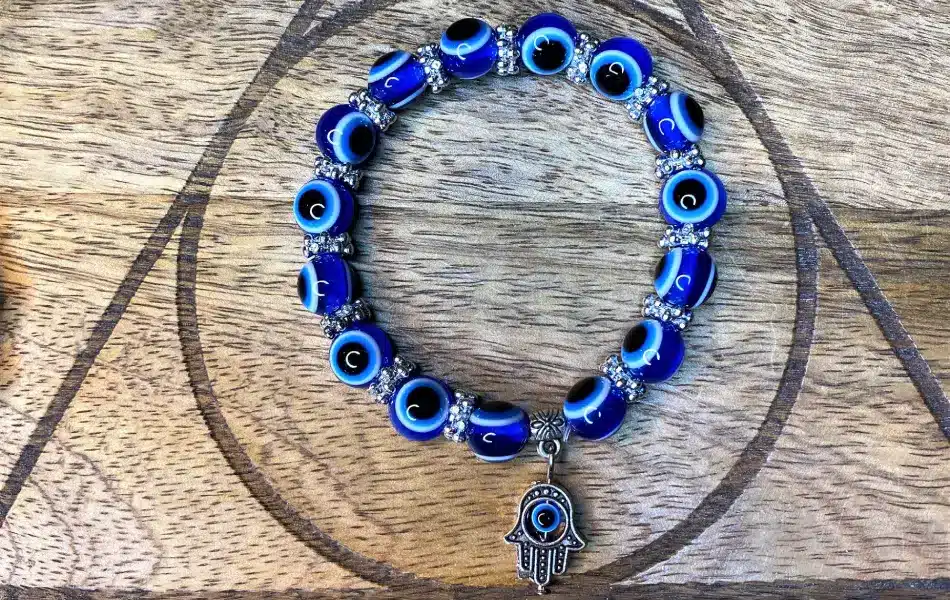The Evil Eye is a pervasive and ancient belief rooted in the notion that envy or malevolent intentions can manifest through a malevolent glare, causing harm, misfortune, or illness to the recipient. This concept transcends cultural and geographical boundaries, with evidence of its existence in civilizations as ancient as Mesopotamia, and it continues to hold sway in various forms across the world today.
Central to the Evil Eye belief is the power of envy, which, when directed towards an individual, is thought to result in detrimental effects. This could range from minor inconveniences to significant life disruptions. The fear of the Evil Eye has led to the creation of numerous protective measures, including amulets, talismans, and rituals, designed to avert or deflect the harmful intentions encapsulated within the gaze.
The symbol most commonly associated with the Evil Eye protection is an eye, often rendered in striking blue, encapsulated within a circle or a charm. This emblem serves as a “mirror” to reflect the malevolent gaze back to the sender, neutralizing its power. The use of the color blue, particularly a deep azure, is believed to have protective qualities, a tradition that can be traced back to ancient civilizations such as the Egyptians and the Greeks.
The Origin of Evil Eye Symbol
The Evil Eye, a symbol entrenched in the annals of human history, represents one of the most enduring anthropological phenomena spanning diverse cultures across the globe.
Its origins, deeply rooted in ancient civilizations, can be traced back to as early as the 5th millennium BCE in Mesopotamia. This emblem of malevolence, believed to be cast by a malevolent glare, is thought to bring misfortune, illness, or even death to its unsuspecting victims.
The premise of the Evil Eye lies in the power of envy and jealousy. In societies both ancient and modern, the success, health, or beauty of an individual can incite covetous glares, believed to harbor supernatural powers capable of bringing about tangible harm. This belief underscores a universal human experience – the complex interplay of social relations, where success can often provoke unintended negative consequences.
The widespread adoption and adaptation of the Evil Eye symbol in various cultures underscore its significance in the human psyche. The ancient Egyptians, for example, revered the Eye of Horus, a symbol closely associated with protection and royal power, as a talisman against the Evil Eye. Similarly, in Greco-Roman traditions, amulets depicting the evil eye, known as “apotropaic” charms, were commonplace. These were believed to reflect or avert the harmful energies directed towards the wearer.
In contemporary times, the Evil Eye persists in various forms, transcending its original contexts to become a popular cultural and fashion symbol. Its representation, often a stylized eye within a blue circle, is not merely ornamental. It carries with it a lineage of protective charm, a silent guardian against the envious gazes of others. This modern incarnation of the Evil Eye, found in jewelry, home decor, and art, serves as a testament to the symbol’s enduring relevance and its ability to adapt to changing cultural landscapes.
Meaning of the Evil Eye in Different Cultures
It’s fascinating to see how this symbol holds varying significance across different cultures, each adding its unique flavor to this age-old belief. Let’s unravel meanings that the Evil Eye carries across various cultural landscapes.
Starting in the Mediterranean, the Evil Eye, or “mal’occhio” in Italy, is steeped in a blend of superstition and tradition. Here, it’s often seen as a curse, unintentionally cast by someone’s envious glance, which could bring misfortune to the unsuspecting. Italians might use charms like the cornicello or gestures like the mano cornuta to ward off its effects. It’s a similar story in Greece and Turkey, where the nazar amulet—a striking blue eye-shaped charm—is ubiquitous, serving as a protector against negative energies.
Shifting to the Middle East, the concept intertwines with religious practices. Phrases like “Masha’Allah” are commonly used to deflect the potential harm of an envious eye, acknowledging that all fortunes come from the divine and thus protecting against jealousy-induced harm.
In South Asia, particularly in India, the Evil Eye, or “Buri Nazar,” extends beyond the human gaze to even encompass favorable remarks, which could inadvertently bring bad luck. Protective symbols and rituals, like the “Nazar Battu” or “black dot,” are commonly used to shield against the unintended consequences of envy.
Across the Atlantic in Latin America, particularly in Brazil, specific plants and amulets are employed to counteract the Evil Eye, showcasing a blend of indigenous and imported beliefs about envy and protection.
It’s not just about warding off bad luck, though. In some cultures, the Evil Eye symbol is also a talisman that brings good fortune, protection, and prosperity. Its use in jewelry and fashion, transcending its traditional protective role, reflects its enduring appeal and evolving interpretations.
This cultural journey of the Evil Eye, from ancient amulets in Egypt to fashionable accessories worldwide, highlights a shared human concern with envy and the desire for protection against unseen forces. Each culture’s interpretation adds a unique layer to understanding the complexity and universality of the Evil Eye phenomenon.
Can positive emotions trigger the Evil Eye?
Yes, positive emotions can indeed trigger the Evil Eye. When someone shares their happiness or achievements, such as getting married or posting about an accomplishment on social media, it might attract envy or misdirected admiration from others. This envy can manifest as the Evil Eye, causing the person who is the object of envy to experience unexplained bad luck or health issues.
Questions about Evil Eye Amulets and Jewelry
How do Evil Eye charms function?
Evil Eye charms function as protective talismans, designed to ward off negative energies and malevolent intentions directed towards the wearer. These charms, often featuring an eye motif, are believed to reflect or absorb the harmful energies of the Evil Eye, preventing them from causing misfortune or harm. They can be attached to various personal items, integrating the protective power of the Evil Eye into daily life.
What are the common colors of Evil Eye amulets and their meanings?
Evil Eye amulets come in a variety of colors, each carrying its own unique meaning and symbolism that caters to different aspects of life and protection. Here’s a breakdown of some common colors and their associated meanings:
- Red symbolizes courage, strength, protection, and energy. It’s believed to fend off negative energy while boosting positivity and vitality, and in some cultures, it’s considered a lucky color.
- Blue, traditionally the most recognized color for the Evil Eye, signifies peace, calm, and protection, embodying serenity and tranquility.
- Green represents prosperity, success, and happiness, and is often associated with personal growth, health, and abundance.
- Yellow or Gold is linked to health, happiness, and relief from exhaustion, promoting a sharper mind and concentration.
- Black is connected to power and influence, believed to ward off negative energy and offer spiritual protection.
- Purple is tied to balance, imagination, and the removal of obstacles, often associated with spirituality and wisdom.
- White symbolizes purity, focus, and clarity, aiding in clearing clutter and obstacles for a fresh start.
- Orange signifies happiness, protection, motivation, and creativity, enhancing positivity and playfulness.
These colors are used in various forms of Evil Eye jewelry, like bracelets, necklaces, charms, and pendants, each serving the dual purpose of protection and a fashion statement. The color you choose can align with your personal needs or desires, whether you’re seeking courage, prosperity, or peace.
Wearing an Evil Eye amulet on the left wrist is common, as it’s believed to intercept negative energies on the side where energy enters the body. However, this can vary based on personal beliefs and cultural interpretations. The important factor is the intention behind wearing the Evil Eye symbol and believing in its protective qualities.
How do Evil Eye bracelets work?
Evil Eye bracelets function as talismans, believed to ward off negative energies and protect the wearer from harm. The central eye symbol, often featured in various designs, is thought to ‘reflect’ ill intent or malevolent glances back to the source. People wear these bracelets not just for their aesthetic appeal but also for their deep-rooted cultural significance and the sense of security they offer against envy and negativity.
On which hand should an Evil Eye bracelet be worn?
Traditionally, an Evil Eye bracelet is worn on the left wrist. This practice is rooted in the belief that the left side of the body is where energy enters, making it more receptive to external influences. By wearing the bracelet on the left wrist, it’s thought to intercept negative energies or ill intentions, providing protection. However, this can vary based on personal or cultural beliefs, and ultimately, the most important aspect is the intention and belief in the protective qualities of the Evil Eye symbol.








